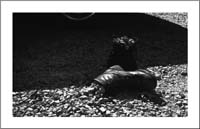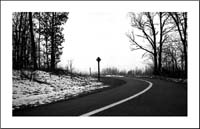| Millikin
University Spring 2004 |
3,000 Thoughts, 30 Images in 3 Books JMS HonorsProject |
book
1 book 2 book 3 |
|||||||
|
|||||||||
3,000 Thoughts, 30 Images in 3 Books by Project
advisor: Annette Russo Over the course of the past three semesters my JMS project has changed shape in several ways and swerved off the original path in which I had planned to get to the end of my project. However, the core ideas and concepts have remained in tact and I have still strove to answer the original question that prompted the idea for this project: Is it possible to combine photographs and haiku together in book format and still retain the creative essence of each unique craft while still reaching/touching all viewers? Working on this project has stretched my capacity for creativity to the limit. Each craft: haiku writing, photography, and book making, could in themselves be turned into a JMS project, so combining them all together in a cohesive form has been challenging to say the least. My original plan for creating this project was to work on each aspect of the project in a stage like manner. For example, I thought that I would be able to write some haiku, edit them, pick out the best ones, and then take some photos to go along with them. After I’d done that a few times, I’d planned on editing the combinations of haiku/photographs and proceed with making a book. I planned to gain new knowledge after each book and apply it to the next. Little did I know that my organizational ideas and my thought processes/creativity were no where close to being on the same page. Not long after I started working on my project I realized that some days it was absolutely impossible for me to write haiku; I just couldn’t get in the correct mindset. Some days too, I didn’t have it in me to take a photograph worthy of being reproduced. So I learned to deal with my erratic inspirational moods and work when it felt right. Many of my haiku/photo combinations where created at separate times, and some were created together in one of those rare moments when inspiration struck me from all angles. I know my sporadic work habits made some people nervous, but I never doubted my abilities. I knew everything would come together if I let it happen…similar to the way a haiku works. Also not long after starting work on my project I realized that limiting myself to photographs of only the figure was a hindrance rather than a help for the project, so I decided to include whatever images I needed to accomplish my goals. I was worried at first that using any subject matter in my photos would take away from the haiku and the personal nature of the project, so I chose to stick to black and white photos only (which was my original intent anyway). Leaving color out of the picture is a substantial way to leave room for viewer imagination. My original plan of gaining new knowledge from each book completed didn’t pan out either. I was worried that if I finished each book separately over a stretch of time that they would no longer look cohesive or appear to belong together in a set. So I wrote all the haiku and took all the photos and then made all three books at once. I also dramatically changed the way I would get my images and haiku on paper. My original plan called for using a technique of Liquid Light, a way photos can be printed on any material. After some trial and error I realized that Liquid Light was not a realistic way to do my project. The images never came out clear or consistently; also with further research I discovered that over time the products of Liquid Light fade away and eventually disappear. That discovery was definitely unsatisfactory for my project. I started looking into other options and eventually landed on the idea of scanning my negatives directly into the computer. I laid out the photos and haiku all on the computer using the programs Adobe Photoshop and Adobe Indesign, which was a challenge since I’m not a graphic design major! (Thank you Rick McCoy for helping me with this.) After all three books were in digital format I took the files to Decatur Blue to be printed on a quality printer. There was some problems getting everything printed, but here again I just learned to be flexible and change my plans yet again. As a result of the printing problems I had to change the dimensions of the books. This little problem turned into a happy mistake because making the books bigger than what I had initially planned on resulted in more dramatic and interesting books. The materials used to make the books were chosen carefully to not only accomplish the task of making all three books cohesive, but also to keep in mind the Zen like feel of the books. Creating books that were beautiful and rich, but also not too busy was important to me and to the integrity of the entire project. After all, presentation is everything. I think I “packaged” the project quite well and succeeded at making beautiful books, but not taking away from the nature of the project. Now that the books have successfully been created I contemplate the last stage of my project, the paper. In my original proposal I wanted to leave the three books untitled and have them on display at my senior show. I wanted to get comments and opinions from viewers on what I should title the books and more importantly if they felt that I had accomplished my goal. I wanted to know, even though the haiku are all snapshots from my life could they relate to them? Even though the photos did not always directly relate to the haiku could the viewer use this extra visual information to enhance their experience? Did I capture the human condition in my work? Although asking viewers these questions was a good plan, I was unable to display my books at my senior show, so I had to rely on the responses of the viewers of my JMS presentation on senior recognition day and the responses of other people that I’ve been able to show my project to. Amazingly, all of my viewers where totally enthralled with my project. Even the haiku/photo combinations that less obviously went together were excepted and celebrated as successful combinations. My viewers verbally expressed their opinions that after reading one of my haiku it made them think of specific moments in their life and because of the ambiguous nature of many of the photos their personal moment went along with the photograph. The amazing relation was more than I had hoped for or expected. Although not all combinations provoked such successful thoughts, all my viewers agreed that they felt connected to the haiku/photos together and also the human condition in general. Some viewers even expressed feelings of inspiration and wanted to know how to write haiku. The word SUCCESS comes to mind here! Although I do feel that I have accomplished my original goal for this project, and accomplished it well, I still feel that something is missing. I think that for me to satisfy the questions and ideas that inspired me to complete this project I’d have to be able to expose my finished project to many more viewers. I want my project to continue to touch and inspire people; to prompt them to feel connected to themselves, nature and the human race all at once. My books just sitting in the Millikin library will not satisfy this need to reach out to more people. The Internet is an excellent solution to this problem, and Dr. Randy Brooks has graciously asked to put my project online. After my work is online I feel confident that it will gain more exposure and touch the minds and imaginations of many. |
|||||||||
—Jennifer
Griebel Decatur, Illinois May 2004 |
|||||||||
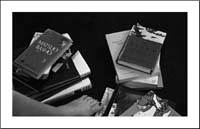
|
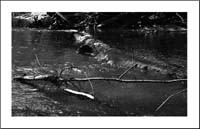
|
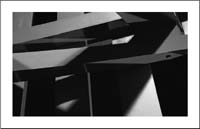
|
 |
||||||
| Millikin
University • JMS Honors Project © 2004 Jennifer Griebel |
|||||||||
